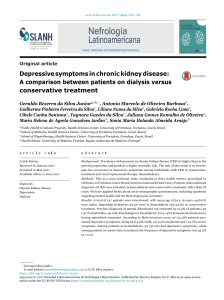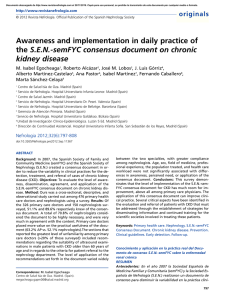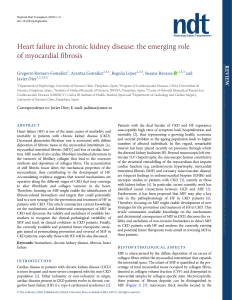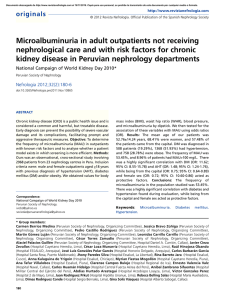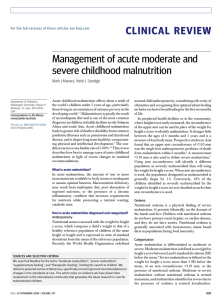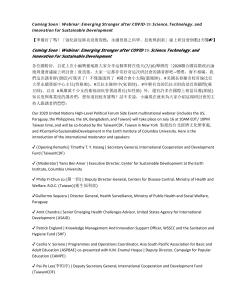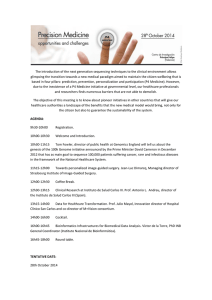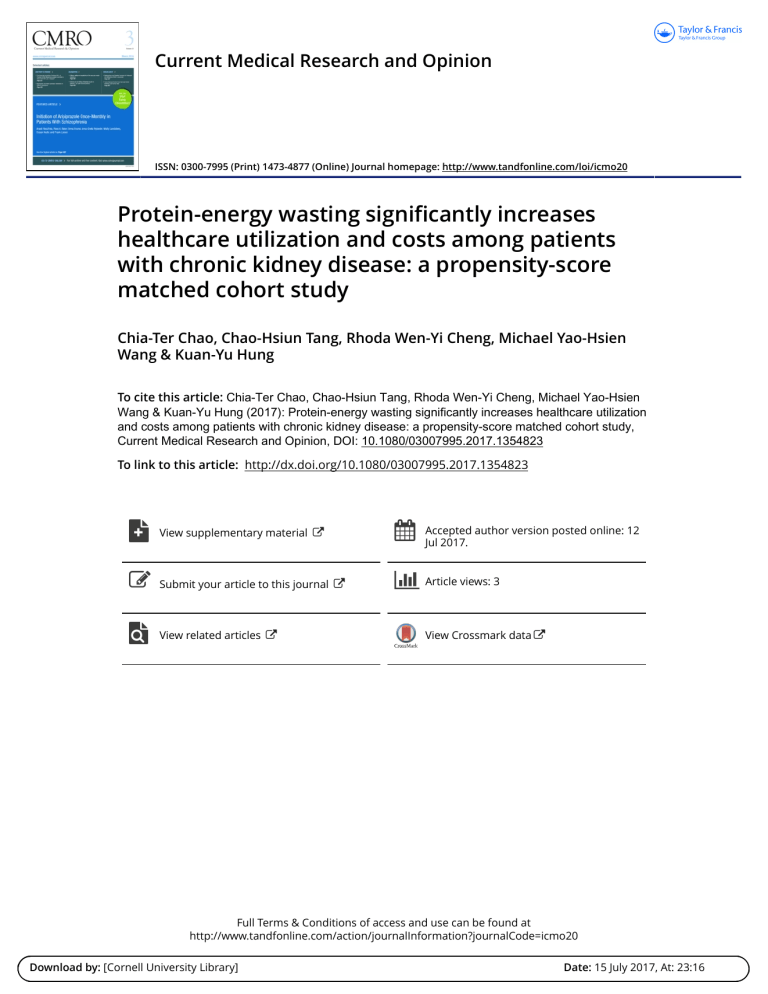
Current Medical Research and Opinion ISSN: 0300-7995 (Print) 1473-4877 (Online) Journal homepage: http://www.tandfonline.com/loi/icmo20 Protein-energy wasting significantly increases healthcare utilization and costs among patients with chronic kidney disease: a propensity-score matched cohort study Chia-Ter Chao, Chao-Hsiun Tang, Rhoda Wen-Yi Cheng, Michael Yao-Hsien Wang & Kuan-Yu Hung To cite this article: Chia-Ter Chao, Chao-Hsiun Tang, Rhoda Wen-Yi Cheng, Michael Yao-Hsien Wang & Kuan-Yu Hung (2017): Protein-energy wasting significantly increases healthcare utilization and costs among patients with chronic kidney disease: a propensity-score matched cohort study, Current Medical Research and Opinion, DOI: 10.1080/03007995.2017.1354823 To link to this article: http://dx.doi.org/10.1080/03007995.2017.1354823 View supplementary material Accepted author version posted online: 12 Jul 2017. Submit your article to this journal Article views: 3 View related articles View Crossmark data Full Terms & Conditions of access and use can be found at http://www.tandfonline.com/action/journalInformation?journalCode=icmo20 Download by: [Cornell University Library] Date: 15 July 2017, At: 23:16 Protein-energy wasting significantly increases healthcare utilization and costs among patients with chronic kidney disease: a propensity-score matched cohort study Chia-Ter Chaoa,b, Chao-Hsiun Tangc, Rhoda Wen-Yi Chengd, Michael Yao-Hsien Wangd, Kuan-Yu Hungb,e a cr ip t Department of Medicine, National Taiwan University Hospital Jin-Shan branch, No.7, Yulu Rd., Wuhu Village, Jinshan Dist., New Taipei City 20844, Taiwan. E-mail: b88401084@gmail.com b Department of Internal Medicine, National Taiwan University Hospital, No. 7, Chung-Shan South Rd., Taipei 10002, Taiwan. c School of Health Care Administration, College of Management, Taipei Medical University, No. 250, Wuxing St., Taipei 11031, Taiwan. E-mail: hsiun.tang@gmail.com d Medical Affairs, Abbott Nutrition, 6F, No. 51, Sec. 3, Min Sheng E. Rd, Taipei 10478 Taiwan. E-mail: rhoda.cheng@abbott.com; michael.wang1@abbott.com e Department of Internal Medicine, National Taiwan University Hospital Hsin-Chu branch, No. 25, Lane 442, Sec.1, Jingguo Rd., Hsinchu City 300, Taiwan. E-mail: kyhung@ntu.edu.tw an us Corresponding author: Kuan-Yu Hung, MD, PhD, Department of Internal Medicine, National Taiwan University Hospital Hsin-Chu branch, No. 25, Lane 442, Sec. 1, Jingguo Road, Hsin-Chu City 300, Taiwan. E-mail: kyhung@ntu.edu.tw ed M TRANSPARENCY Declaration of Funding Abbott provided funding to support manuscript publication; however, this research work did not receive any specific grant from funding agencies in the public, commercial, or not-for-profit sectors. The funder has no role in the analysis, the interpretation of results, and discussion of this study. Ac ce pt Declaration of conflict of Interest KYH has received grant funding and consultancy fees from Abbott Nutrition. RWYC and MYHW are employees of Abbott Nutrition; however, the information presented in this article is based on clinical evidence and is not influenced by any financial relationship. CHT and CTC, have no relevant financial or non-financial competing interests to declare. CMRO peer reviewers on this manuscript have no relevant financial or other relationships to disclose. Author contributions CHT and KYH designed and conducted the study, analyzed and interpreted the data, and drafted the manuscript; CTC conducted the study and interpreted data. RWYC and MYHW coordinated and managed the research project. All authors critically reviewed manuscript drafts for important intellectual content and approved the final version submitted. Acknowledgement The authors thank Dr. David Neil, of Content Ed Net (Taiwan), for his English editing services, which were funded by Abbott Laboratories Services Corp., Taiwan Branch. an us cr ip t Abstract Background: Disease-related malnutrition is highly prevalent and has prognostic implications for patients with chronic kidney disease (CKD); however, few studies have investigated the impact of malnutrition, or protein-energy wasting (PEW), on healthcare utilization and medical expenditure among CKD patients. Methods: Using claim data from the National Health Insurance in Taiwan, we identified patients with CKD between 2009 and 2013 and categorize into those with mild, moderate, or severe CKD. Cases with PEW after CKD was diagnosed were propensity-score matched with controls in 1:4 ratio. We compared healthcare resource utilization metrics including outpatient and emergency department visits, frequency and duration of hospitalization, and the cumulative costs associated with different CKD severity. Results: From among 347,501 CKD patients, we selected eligible cohorts of 66,872 with mild CKD (49.2%), 27,122 with moderate CKD (19.9%), and 42,013 with severe CKD (30.9%). Malnourished CKD patients had significantly higher rates of hospitalization (p < 0.001 for all severities) and re-admission (p = 0.015 for mild CKD, p = 0.002 for severe CKD) than non-malnourished controls. Cumulative medical costs for outpatient and emergency visits, and hospitalization, were significantly higher among all malnourished CKD patients than non-malnourished ones (p < 0.001); total medical costs were also higher among malnourished patients with mild (62.9%), moderate (59.6%), or severe (43.6%) CKD compared to non-malnourished patients (p < 0.001). Conclusions: In a nationally-representative cohort, CKD patients with PEW had significantly more healthcare resource utilization and higher aggregate medical costs than those without, across the spectrum of CKD: preventing PEW in CKD patients should receive high priority if we would like to reduce medical costs. M Key words: Chronic kidney disease; Emergency department; End-stage renal disease; Healthcare utilization; Medical costs; Protein-energy wasting; Re-admission. Running Title: Malnutrition and healthcare utilization in CKD patients Ac ce pt ed Abbreviations: BMI, body mass index; CCI, Charlson Comorbidity Index; CKD, chronic kidney disease; ESRD, end-stage renal disease; ICD, International Classification of Disease; US, United States. Introduction Malnutrition denotes a state of deficient nutrition due to inadequate or imbalanced nutrient intake (general or specific), which results in altered body composition and detriments clinical outcomes.1 Malnutrition has a tremendous global impact; compared to well-nourished patients, malnourished ones are more likely to be hospitalized, have procedure-related complications, and higher mortality.2,3 Besides children and the famine-stricken, in whom the adverse consequences of malnutrition are well-known, it has become apparent that aged and disease-affected individuals are also highly susceptible to malnutrition. Disease-related malnutrition is particularly exigent because of its high prevalence in various clinical settings, its contribution to poor functional recovery and survival, and low awareness about this problem due to inconsistent terminology and definitions.4-6 International nutritional societies advocate diagnosing malnutrition based on etiologic factors including inflammatory status, with definitive diagnosis by either low body-mass index (BMI), or combined weight loss and reduced BMI or fat-free mass index.1,5 an us cr ip t Disease-related malnutrition is very common among patients with chronic kidney disease (CKD) or end-stage renal disease (ESRD), now termed protein-energy wasting (PEW), with estimated prevalence of 40% to 89%7-9, depending upon the assessment methods used. Despite considerable progress in treating ESRD, high prevalence of PEW has been augmented by rising incidence over time.10 Factors presumed to play a pathogenic role in PEW among CKD/ESRD patients include: coexisting gastrointestinal and/or psychiatric illnesses; chronic low grade inflammation with cytokine influences; a uremic central nervous system milieu with nausea and appetite alterations; and defective taste sensing.10,11 The complex interplay between such factors further contributes to the significant detrimental effect of PEW on CKD/ESRD patient outcomes. ce pt ed M Besides compromising outcomes, malnutrition also incurs considerable costs; researchers in the Netherlands reported that managing malnutrition accounted for 2% of annual national healthcare expenditure.12 In general, malnourished patients with medical and surgical illnesses have 50% higher medical costs than well-nourished ones, as a consequence of relatively longer hospital stays and higher requirements for medical attention.13,14 However, published reports on the economic impact of malnutrition are mostly based on data from single institutes or regional registries, and involve cohorts such as hospitalized patients or those with cancer2,15,16 – rarely CKD/ESRD patients. Hence, we used a well-validated health insurance claims database in Taiwan to investigate whether PEW significantly increases healthcare utilization and medical costs among patients with CKD/ESRD. Ac Methods Study design Analytic data were excerpted from the research database provided by the National Health Insurance Administration in Taiwan, which has reimbursed nearly 100% of national healthcare services since 1995. The broad array of reimbursed services, which include emergency, inpatient and outpatient care, surgery, and medication prescriptions, permits precise estimation of healthcare resource utilization and medical costs among patients with any specific illness – in this instance, CKD. All clinical data relevant to CKD were excerpted, including demographic profiles, comorbidities and in-hospital diagnosis, drugs, and procedures. Establishment of CKD cohorts cr ip t Fig. 1 shows the patient selection process. CKD was defined by three consecutive outpatient visits or a single hospitalization with an International Classification of Diseases 9th Version – Clinical Modification (ICD-9-CM) diagnostic code denoting CKD (ICD-9-CM 585.1–585.9 and/or V45.11)17, from 2009 to 2013. Enrolled CKD patients were divided into groups with mild, moderate, or severe CKD, according to specific criteria. Severe CKD was defined as having procedural codes for hemodialysis > 26 times in 90 days, or peritoneal dialysis > 3 times in 90 days, a catastrophic illness certificate for ESRD, and documented evidence of ESRD persisting > 3 months.18,19 Procedure codes are codes used by healthcare facilities to specify reimbursable operations or interventions and to report to National Health Insurance Bureau in Taiwan, while catastrophic illness certificates are documents that confirm the presence of government-recognized serious illnesses, and are issued only after a formal review by expert panels of discipline-specific specialists.20 Since patients who possess these certificates do not need to make copayment for the medical care they receive, the review process is very stringent and carries high credibility. The use of catastrophic illness certificates and procedure codes to increase the accuracy of identifying patients with ESRD has been utilized repetitively in the literature and exhibits high specificity.18,21 ed M an us The criteria defining moderate CKD were having received erythropoiesis-stimulating agents to treat CKD within 12 months before the index date22 (according to Taiwan National Health Insurance policy, only those with CKD and a serum creatinine > 6 mg/dL or estimated glomerular filtration rate < 15 ml/min/1.73 m2 are eligible for reimbursed erythropoiesis-stimulating agents), but having no ESRD catastrophic illness certificate or dialysis codes; in addition, such patients had to be free of cancer or hematologic illnesses that might also indicate erythropoiesis-stimulating agents. Mild CKD was defined as having received angiotensin-converting enzyme inhibitors or angiotensin receptor blockers for ≥ 3 months during the index enrollment year, but not having a catastrophic illness certificate, dialysis procedure codes, or receiving erythropoiesis-stimulating agents during the year preceding the index date. Ac ce pt Patients assigned procedural codes during 2009 were excluded to ensure that clinical features, including comorbidities, had existed for at least one year preceding the enrollment index date, which was defined as the date participants were first given the ICD-9-CM code for CKD and/or dialysis. In addition, patients with moderate or mild CKD who had received dialysis for non-standard acute treatment, as well as some with mild CKD who had received erythropoiesis-stimulating agents for a short period before the index date were excluded, as were patients with presumed diagnoses of PEW during the year preceding the index date (based on ICD-9-CM codes including: 260–263, 263.0, 263.2, 263.8, 263.9, 265, 265.0–265.2, 266, 266.0– 266.2, 266.9, 268, 268.0–268.2, 268.9, 799, 799.0–799.02, 799.1, 799.2, 799.21–799.25, 799.29, 799.3– 799.5, 799.51–799.55, 799.59, 799.8, 799.81, 799.82, 799.89, and 799.9).23 Since the National Health Insurance database we used did not record laboratory parameters including serum creatinine, albumin, or anthropometric variables (body mass index or body composition data), we could only use the diagnostic codes of PEW to capture malnourished CKD cases. Charlson Comorbidity Index (CCI) scores, excluding the contribution of CKD, were calculated based on the comorbidity profiles recorded during the year preceding the index date. From among each CKD severity group, patients with presumed PEW after the index date, based on the aforementioned ICD-9-CM codes, constituted cases. Logistic regression was used to model the risk of mortality in different CKD groups as a function of participants’ sociodemographic characteristics (age, sex, residential location), comorbidity profile and CCI scores. Based on the regression results, a propensity-score matched group was identified using an established procedure24, with a balanced distribution of covariates between CKD patients of differing severity and with and without PEW, to serve as controls. CKD patients defined as having PEW were matched 1:4, without replacement, to those without malnutrition, based on a nearest neighbor approach. Both cases and controls in mild, moderate, and severe CKD groups were prospectively followed up from the index date until death or 31 December 2013, whichever occurred first. Outcome of interest The primary outcome was extent of healthcare resource utilization, which included: the annual frequency of outpatient and emergency department visits; the annual frequency and duration of hospitalization; and the cumulative costs associated with different categories of medical care during the period between index date and the end of follow-up, converted to United States (US) dollars at the time of analysis. Statistical analysis M an us cr ip t Statistical analyses were performed using R-2.11.1 for Windows software (R Foundation for Statistical Computing, Vienna, Austria)25, run on Microsoft Windows 7 Operating System. For clinical features including sociodemographic and comorbidity data, and all outcomes, continuous variables were expressed as mean and standard deviation (SD), compared using Student’s t-test. Categorical variables were expressed as percentages, and compared using the Chi-square text. We constructed survival curves based on the absence or presence of malnutrition in groups with differing CKD severity using Kaplan-Meier analysis, and compared results with a log-rank test. Cox proportional hazard regression analysis, incorporating sociodemographic variables, CCI, and PEW or not, was applied to assess the relationship between malnutrition and mortality, as well as developing ESRD after follow-up, in each CKD subgroup. We compared the extent of healthcare resource utilization and cumulative medical costs between patients with mild, moderate, or severe CKD, with or without PEW, to identify the economic impact of PEW on each CKD category. ce Results pt ed Ethics statement The National Taiwan University Hospital Ethics Committee approved the study, and waived the requirement for informed consent as the National Health Insurance Research Database used enciphers patient identification numbers to ensure anonymity and privacy. Ac Between 2009 and 2013 the Taiwan National Health Insurance database registered 347,501 patients with ICD-9-CM codes of 585.1–585.9 (CKD) and/or V45.11 (dependence on renal dialysis), from among whom 66,782 with mild CKD (49.2%), 27,122 with moderate CKD (19.9%), and 42,013 with severe CKD (30.9%) were selected according to the inclusion/exclusion criteria used in this study (Fig. 1) for 1:4 propensity-score matching22 of those with or without PEW; subsequent case-control analysis included 1087 patients with mild CKD, 408 with moderate CKD, and 1433 with severe CKD. In general, CKD patients with and without PEW had similar sociodemographic and comorbidity profiles (Table 1). However, some differences were statistically significant; patients with mild CKD and PEW had lower prevalence of heart failure, while those with moderate CKD and PEW had proportionally less peripheral vascular disease and moderate to severe hepatic disease, and higher prevalence of dementia. After an average of 4 years’ follow-up, patients with CKD of any severity and PEW had significantly higher mortality rates than those without PEW (Table 2 and supplementary Fig. 1). Cox proportional hazard regression analyses showed that patients with PEW were twice as likely to die, irrespective of CKD severity, and that those with mild or moderate CKD had higher risk of developing ESRD (Table 3). Compared with CKD patients without PEW, PEW-positive counterparts with mild, moderate or severe CKD also had significantly higher rates of hospitalization and re-admission within 30 days of a previous hospitalization (Table 2, Fig. 2), as well as significantly higher frequencies of emergency and outpatient visits, and days hospitalized per year. Consequently, healthcare expenditure of patients with CKD and PEW was significantly higher than on those without PEW, with severe CKD group incurring the highest inpatient, medication, and total costs (Fig. 3). Discussion cr ip t This study shows that PEW significantly detriments survival and renal prognosis of patients with mild to severe CKD. Moreover, PEW also increases healthcare utilization by CKD patients, including more frequent outpatient visits, up to twice as many emergency department visits, and two- to four-fold higher hospitalization rates, with consequently increased healthcare costs, especially among patients with severe CKD – a rarely-reported finding. ce pt ed M an us In this study, we found that patients with moderate CKD and PEW exhibited numerically higher mortality than those with mild or severe CKD and PEW. It is expectable that those with moderate CKD and PEW had higher mortality than those with mild CKD and malnutrition, but the finding that those with moderate CKD and PEW had higher mortality than those with severe CKD and PEW is unexpected. Several reasons might be responsible for this phenomenon. First of all, patients with moderate CKD and PEW had higher prevalence of peripheral vascular disease, dementia, moderate to severe liver disease, and any cancer (Table 1) than those with severe CKD and PEW. These comorbidities have been reported to increase the risk of mortality among CKD patients, and this higher comorbidity prevalence may correlate with worse outcomes.26-28 Alternatively, the higher mortality in patients with moderate CKD and PEW than those with severe CKD might be explained by a relatively decreased mortality in the latter group. It has been widely recognized that patients with ESRD, especially those of advanced age, with frailty, or with poor functional status, tend to be offered conservative management including dialysis withhold and palliative care, and this is also the case in Taiwan.29,30 It is possible that the prevalent ESRD patients we enrolled to form the severe CKD group, were of younger age and had comparatively better functional status than those with mild or moderate CKD. This is supported by our finding that the age of patients with severe CKD was lower than that of those with mild or moderate (Table 1). Further studies are needed in this regard. Ac CKD patients are at higher risk of PEW due to gastrointestinal, psychiatric, and central nervous systems perturbation, and being malnourished detriments patient outcomes31; PEW in patients with CKD has been associated with up to three-fold higher risk of mortality32,33 or ESRD.34-36 However, few have addressed the question of whether or how PEW is related to deteriorating renal function in CKD; furthermore, published results are controversial, owing to being from a single center or having limited cohort sizes.37,38 In this national cohort from Taiwan, we found that CKD patients with PEW had two-to-three-fold higher risk of ESRD than those without; this finding highlights the prognostic significance of PEW in CKD in addition to its well-known impact on overall survival. Malnutrition not only detriments health-related patient outcomes, but also imposes an economic burden on the healthcare system; the correlation between malnutrition and increased use of healthcare resources has been recognized previously. Mosquera et al reported recently that malnourished patients receiving major surgery were more likely than those without malnutrition to receive emergency procedures, had cr ip t longer postoperative hospital stays, and higher rates of complications and readmission, all of which use more resources and incur greater spending.39 It has been estimated that hospitalized patients with malnutrition cost 20% to 38% extra to treat.13,14 A similar relationship is evident in disease-associated malnutrition; for example, Hoong et al reported that patients with chronic obstructive pulmonary disease patients were admitted more frequently if they had malnutrition, and also had longer hospital stays, doubling total medical costs.40 In another large US study, the direct costs of disease-associated malnutrition exceeded 15 billion US dollars, with malnourished patients with dementia and depression accounting for two-thirds.41 This issue has rarely been addressed in patients with CKD/ESRD, among whom available reports focused on the costs associated with the use of vitamin D, phosphate-binder, and intra-dialytic supplementation.42,43 We found that malnutrition in CKD/ESRD patients, or PEW, likewise, increased their healthcare utilization and costs. Interestingly, the extent of increased total cost relating to PEW in CKD (20% to 30%; Fig. 3) appears lower than that in patients hospitalized for surgical (50% or higher) or other medical illnesses (50% to three-fold)2,3,13,39,44; this might be because the risk of developing PEW among CKD patients is high, and some patients in the propensity-matched control group might have clinical malnutrition not detectable by administrative coding. On the other hand, patients with CKD tend to use more healthcare resources than those without45, which would potentially lessen the discrepancy between those with and without PEW, by augmenting the denominator. These issues should be taken into account when we evaluate the economic burdens of malnutrition associated with different diseases. Ac ce pt ed M an us Accurate identification of malnutrition in clinical practice is an imperative, though controversial, issue. Professional societies recommend screening using validated tools (Mini-Nutritional Assessment, Subjective Global Assessment, Nutritional Risk Screening), to identify individuals at-risk for malnutrition, followed by definitive diagnosis based on BMI and body composition parameters.1,46 However, studies to date have had serious methodological shortcomings, including inadequate statistical power, preferential selection of those amenable to receiving assessment, and inconsistent ascertainment methods. Accordingly, researchers have begun to identify malnourished patients through electronic medical records of administrative codes for malnutrition, to mitigate heterogeneity across institutes, patient populations, and healthcare settings.23 Marco et al estimated the prevalence and risk factors for malnutrition in hospitalized patients using ICD-9-CM codes in a nationwide database, and found that malnutrition was commonly linked to dementia, cancer, and CKD.47 Corkins et al, using a composite set of malnutrition coding based on ICD-9-CM, determined that 3.2% of all hospitalizations in the US had a diagnosis of malnutrition, and that malnourished patients had significantly longer hospital stays and higher total medical costs.44 These results indicate that malnutrition identified by administrative codes has similar prognostic implications as malnutrition that is assessed objectively. We extracted clinical and reimbursement data from a claim-based database, and defined malnutrition, or PEW by ICD-9-CM codes, which was similarly associated with higher mortality and worse renal deterioration. More importantly, this approach facilitated a more comprehensive analysis of healthcare expenditure in patients with CKD, an ever-increasing population that warrants heightened attention. We contend that estimating healthcare utilization and costs using a population-based database provides a more realistic and balanced view of the negative impact of malnutrition. Limitations Our results should be interpreted carefully, in light of several limitations. First, CKD severity was not categorized according to the ICD-9-CM diagnostic codes qualifying for entry into the study, but by using subsequent procedural codes as surrogates; therefore, the proportions designated mild, moderate, and severe, may not correspond to clinically determined diagnoses. Likewise, cases with PEW based on administrative data might under-estimate the true prevalence in clinical practice, since under-reporting for hospitalized patients is common.48 Nevertheless, we suppose that if statistical significance is achieved based on analyzing the CKD population with PEW, it follows that the difference in healthcare utilization and costs will be even greater after analyzing the entire CKD population. In addition, expert consensus recommends that PEW be used to describe typical CKD-associated body mass and fuel reserve loss instead of conventional terms including uremic malnutrition, protein-energy malnutrition, or malnutrition-inflammation complex syndrome49; the term malnutrition consists of under-nutrition and over-nutrition in other disease status, and thus we used PEW in this study to avoid confusion. To define PEW, it would be best to have serum biochemical data such as albumin, prealbumin, or anthropometric parameters, body composition indices, or dietary recordings49, but these data are not available in claim-based administrative database we used in this study. Since we had no objective measures of PEW severity, we could not analyze how the extent of PEW impacted analyzed variables. Finally, the Taiwan National Health Insurance Administration database does not record laboratory data values such as albumin or pre-albumin levels. ip t Conclusion Ac ce pt ed M an us cr Malnutrition detriments patient outcomes and we have broadened evidence of its influence to encompass a pharmaco-economic burden; our findings affirm that malnutrition, or PEW also incurs considerably increased in healthcare resource utilization and medical costs in patients with CKD/ESRD, who are an expanding population due to population aging, rising prevalence of the metabolic syndrome, and the emergence of multimorbidity. To ameliorate these burdens, high priority should be given to preventing patients with CKD from developing PEW. References Cederholm T, Bosaeus I, Barazzoni R, et al. Diagnostic criteria for malnutrition – An ESPEN Consensus Statement. Clin Nutr. 2015;34:335–340. 2. Thomas MN, Kufeldt J, Kisser U, et al. Effects of malnutrition on complication rates, length of hospital stay, and revenue in elective surgical patients in the G-DRG-system. Nutrition. 2016;32:249–254. 3. Correia MI, Waitzberg DL. The impact of malnutrition on morbidity, mortality, length of hospital stay and costs evaluated through a multivariate model analysis. Clin Nutr. 2003;22:235–239. 4. Caillet P, Liuu E, Raynaud Simon A, et al. Association between cachexia, chemotherapy and outcomes in older cancer patients: A systematic review. Clin Nutr. 2016 Dec 18. pii: S0261-5614(16)31344-9. doi: 10.1016/j.clnu.2016.12.003. 5. Jensen GL, Mirtallo J, Compher C, et al; International Consensus Guideline Committee: Adult starvation and disease-related malnutrition: a proposal for etiology-based diagnosis in the clinical practice setting from the International Consensus Guideline Committee. JPEN J Parenter Enteral Nutr. 2010;34:156– 159. 6. Marshall S. Protein-energy malnutrition in the rehabilitation setting: Evidence to improve identification. Maturitas. 2016;86:77–85. 7. Mehrotra R, Kopple JD. Nutritional management of maintenance dialysis patients: why aren't we doing better? Annu Rev Nutr. 2001;21:343–379. 8. Desbrow B, Bauer J, Blum C, et al. Assessment of nutritional status in hemodialysis patients using patient-generated subjective global assessment. J Ren Nutr. 2005;15:211–216. 9. Westland GJ, Grootendorst DC, Halbesma N, et al. The nutritional status of patients starting specialized predialysis care. J Ren Nutr. 2015;25:265–270. 10. Fouque D, Pelletier S, Mafra D, et al. Nutrition and chronic kidney disease. Kidney Int. 2011;80:348– 357. 11. Kalantar-Zadeh K, Block G, McAllister CJ, et al. Appetite and inflammation, nutrition, anemia, and clinical outcome in hemodialysis patients. Am J Clin Nutr. 2004;80:299–307. 12. Freijer K, Tan SS, Koopmanschap MA, et al. The economic costs of disease related malnutrition. Clin Nutr. 2013;32:136–141. 13. Curtis LJ, Bernier P, Jeejeebhoy K, et al. Costs of hospital malnutrition. Clin Nutr. 2016 Sep 19. pii: S0261-5614(16)31247-X. doi: 10.1016/j.clnu.2016.09.009. 14. Amaral TF, Matos LC, Tavares MM, et al. The economic impact of disease-related malnutrition at hospital admission. Clin Nutr. 2007;26:778–784. 15. Melchior JC, Préaud E, Carles J, et al. Clinical and economic impact of malnutrition per se on the postoperative course of colorectal cancer patients. Clin Nutr. 2012;31:896–902. 16. Gastalver-Martín C, Alarcón-Payer C, León-Sanz M. Individualized measurement of disease-related malnutrition's costs. Clin Nutr. 2015;34:951–955. 17. Chen YC, Lin HY, Li CY, et al. A nationwide cohort study suggests that hepatitis C virus infection is associated with increased risk of chronic kidney disease. Kidney Int. 2014;85:1200–1207. 18. Chao CT, Hou CC, Wu VC, et al. The impact of dialysis-requiring acute kidney injury on long-term prognosis of patients requiring prolonged mechanical ventilation: nationwide population-based study. PLoS One. 2012;7:e50675. 19. Weng SF, Jan RL, Chang C, et al. Risk of Band Keratopathy in Patients with End-Stage Renal Disease. Sci Rep 2016;6:28675. 20. https://www.nhi.gov.tw/english/Content_List.aspx?n=F5B8E49CB4548C60&topn=1D1ECC54F86E9050 (assessed in 2017/06/29) 21. Wang WJ, Chao CT, Huang YC, et al. The impact of acute kidney injury with temporary dialysis on the risk of fracture. J Bone Miner Res. 2014;29:676-84 Ac ce pt ed M an us cr ip t 1. Ac ce pt ed M an us cr ip t 22. Shih CJ, Chen YT, Ou SM, et al; Taiwan Geriatric Kidney Disease Research (TGKD) Group: The impact of dialysis therapy on older patients with advanced chronic kidney disease: a nationwide population-based study. BMC Med. 2014;12:169. 23. Giannopoulos GA, Merriman LR, Rumsey A, et al. Malnutrition coding 101: financial impact and more. Nutr Clin Pract. 2013;28:698–709. 24. Austin PC, Laupacis A. A tutorial on methods to estimating clinically and policy-meaningful measures of treatment effects in prospective observational studies: a review. Int J Biostat. 2011;7:6. 25. R Development Core Team (2010). R: A language and environment for statistical computing. R Foundation for Statistical Computing, Vienna, Austria. ISBN 3-900051-07-0, http://www.R-project.org/ 26. Fabrizi F, Messa P, Basile C, et al. Hepatic disorders in chronic kidney disease. Nat Rev Nephrol. 2010;6:395-403. 27. Chao CT, Hsu YH, Chang PY, et al. Simple self-report FRAIL scale might be more closely associated with dialysis complications than other frailty screening instruments in rural chronic dialysis patients. Nephrology. 2015;20:321-328. 28. Berger I, Wu S, Masson P, et al. Cognition in chronic kidney disease: a systematic review and meta-analysis. BMC Med. 2016;14:206. 29. Chao CT, Tsai HB, Shih CY, et al. Establishment of a renal supportive care program: experience from a rural community hospital in Taiwan. J Formos Med Assoc. 2016;115:490-500. 30.Davison SN, Jassal SV. Supportive care: integration of patient-centered kidney care to manage symptoms and geriatric syndromes. Clin J Am Soc Nephrol. 2016;11:1882-1891. 31. Zha Y, Qian Q. Protein nutrition and malnutrition in CKD and ESRD. Nutrients. 2017;9:E208. 32. Kovesdy CP, Anderson JE, Kalantar-Zadeh K. Paradoxical association between body mass index and mortality in men with CKD not yet on dialysis. Am J Kidney Dis. 2007;49:581–591. 33. Ikizler TA. Nutrition, inflammation and chronic kidney disease. Curr Opin Nephrol Hypertens. 2008;17:162–167. 34. Kalantar-Zadeh K, Ikizler TA, Block G, et al. Malnutrition-inflammation complex syndrome in dialysis patients: causes and consequences. Am J Kidney Dis. 2003;42:864–881. 35. Kalantar-Zadeh K, Kopple JD. Relative contributions of nutrition and inflammation to clinical outcome in dialysis patients. Am J Kidney Dis. 2001;38:1343–1350. 36. Qureshi AR, Alvestrand A, Divino-Filho JC, et al. Inflammation, malnutrition, and cardiac disease as predictors of mortality in hemodialysis patients. J Am Soc Nephrol. 2002;13 Suppl 1:S28–S36. 37. Chang YT, Wu HL, Guo HR, et al. Handgrip strength is an independent predictor of renal outcomes in patients with chronic kidney diseases. Nephrol Dial Transplant. 2011;26:3588–3595. 38. Kovesdy CP, George SM, Anderson JE, et al. Outcome predictability of biomarkers of protein-energy wasting and inflammation in moderate and advanced chronic kidney disease. Am J Clin Nutr. 2009;90:407–414. 39. Mosquera C, Koutlas NJ, Edwards KC, et al. Impact of malnutrition on gastrointestinal surgical patients. J Surg Res. 2016;205:95–101. 40. Hoong JM, Ferguson M, Hukins C, et al. Economic and operational burden associated with malnutrition in chronic obstructive pulmonary disease. Clin Nutr. 2017;36:1105-1109. 41. Goates S, Du K, Braunschweig CA, et al. Economic Burden of Disease-Associated Malnutrition at the State Level. PLoS One. 2016;11:e0161833. 42. Ikizler TA. Nutrition support for the chronically wasted or acutely catabolic chronic kidney disease patient. Semin Nephrol. 2009;29:75–84. 43. Brunner-Ziegler S, Fröschl B, Hiebinger C, et al. Effectiveness and cost-efficacy of phosphate binders in hemodialysis. Ann Nutr Metab. 2011;58:315–319. Ac ce pt ed M an us cr ip t 44. Corkins MR, Guenter P, DiMaria-Ghalili RA, et al; American Society for Parenteral and Enteral Nutrition: Malnutrition diagnoses in hospialized patients: United States, 2010. JPEN J Parenter Enteral Nutr. 2014;38:186–195. 45. Alexander M, Bradbury BD, Kewalramani R, et al. Chronic kidney disease and US healthcare resource utilization in a nationally representative sample. Am J Nephrol. 2009;29:473–482. 46. Cederholm T, Jensen GL. To create a consensus on malnutrition diagnostic criteria: A report from the Global Leadership Initiative on Malnutrition (GLIM) meeting at the ESPEN Congress 2016. Clin Nutr. 2017;36:7-10. 47. Marco J, Barba R, Zapatero A, et al. Prevalence of the notification of malnutrition in the departments of internal medicine and its prognostic implications. Clin Nutr. 2011;30:450–454. 48. Khalatbari-Soltani S, Waeber G, Marques-Vidal P. Estimation of malnutrition prevalence using administrative data: Not as simple as it seems. Clin Nutr. 2015;34:1276–1277. 49. Fouque D, Kalantar-Zadeh K, Kopple J, et al. A proposed nomenclature and diagnostic criteria for protein-energy wasting in acute and chronic kidney disease. Kidney Int. 2008;73:391-398. Figure legends Fig. 1. Selection of cases and propensity-score matched controls ACEI, angiotensin converting enzyme inhibitor; ARB, angiotensin receptor blocker; ESA, erythropoiesis-stimulating agents; ESRD, end-stage renal disease; HD, hemodialysis; NHIRD, Taiwan National Health Insurance Research Database; PD, peritoneal dialysis; ICD-9-CM, International Classification of Diseases 9th Version – Clinical Modification. a Three consecutive outpatient visits or one hospitalization. b ACEIs or ARBs for ≥ 3 months during the index enrollment year. c Concurrent ESA before the index date, with no cancer or hematologic illness. d Catastrophic illness certificate for ESRD, documentary evidence of ESRD persisting longer than 3 months, and procedural codes of HD or PD. e Based on ICD-9-CM codes listed in the method section cr ip t Fig. 2. Healthcare resource utilization among malnutrition/PEW positive and malnutrition/PEW negative patients with CKD of different severity. * p < 0.001 CKD, chronic kidney disease; PEW, protein-energy malnutrition Supplementary figure legends ed M an us Fig. 3. Healthcare expenditure incurred by malnutrition/PEW positive and malnutrition/PEW negative patients with CKD of different severity. * p < 0.001 CKD, chronic kidney disease; PEW, protein-energy malnutrition Ac ce pt Supplementary Fig. 1. Survival rates of CKD patients with versus without PEW. Data analyzed by Kaplan-Meier method and compared by the log-rank test. CKD, chronic kidney disease; PEW, protein-energy malnutrition. pt ce Ac ed cr us an M t ip pt ce Ac ed cr us an M t ip pt ce Ac ed cr us an M t ip Table 1. Demographic and clinical characteristics of CKD patients with and without protein-energy wasting, after propensity-score matching CKD severity PEW status Mild Moderate Severe Case Control p-value Case Control p-value Case Control p-value 74.1 ± 73.6 ± 0.244 71.9 71.4 ± 0.463 70.5 70.3 ± 12.6 12.2 ± 13.3 ± 13.7 0.620 76.8 1.000 Demographic data Mean age (years ± SD) 13.9 86.5 86.9 80.9 80.8 76.7 ip t Proportion > 60 vs ≤ 60 (%) 14.0 57.1 57.0 57.1 1.000 Urban (%) 56.5 56.6 59.3 Rural (%) 43.5 43.4 0.9 0.71 Charlson Comorbidity Index 0.744 ed scores M Comorbidity profile 88.5 89.1 pt 0–2 3–5 57.1 0.935 57.0 0.999 an Urban vs. rural location 57.0 us Male (%) 0.935 cr 0.935 Male vs. female sex 59.4 1.000 63.4 63.5 36.6 36.5 1.50 1.38 40.7 40.6 1.25 1.14 80.9 81.5 75.4 76.3 0.543 0.085 9.4 9.1 16.4 16.7 21.1 21.3 2.1 1.8 2.7 1.8 3.6 2.5 0.16 0.61 0.875 0.59 2.21 0.840 0.68 2.65 0.844 Congestive heart failure (%) 0.88 2.72 0.020 3.14 11.7 0.597 3.20 13.9 0.204 Peripheral vascular disease (%) 0.08 0.28 0.593 0.44 0.59 0.023 0.25 0.64 0.103 Cerebrovascular disease (%) 0.67 2.38 0.352 1.32 4.71 0.577 1.70 5.76 0.092 Dementia (%) 0.06 0.34 0.347 0.39 0.34 0.004 0.21 0.59 0.231 COPD (%) 0.48 1.86 0.856 1.08 3.82 0.608 1.14 4.12 0.383 Rheumatologic disease (%) 0.05 0.13 0.393 0.10 0.34 1.000 0.22 0.71 0.425 Peptic ulcer (%) 0.60 2.29 0.703 1.62 7.40 0.463 2.16 7.61 0.136 ce ≥6 Ac Acute myocardial infarction (%) Hepatic disease Mild 0.14 0.59 0.914 0.78 1.81 0.060 0.81 2.48 0.074 0.03 0.18 0.452 0.29 0.34 0.030 0.14 0.66 0.642 1.79 7.18 0.962 4.51 19.17 0.549 5.81 21.49 0.1 0.73 2.98 0.828 2.60 13.28 0.074 4.23 18.00 0.268 0.05 0.25 0.617 0.10 0.29 0.664 0.17 0.31 0.025 Any 0.48 1.81 0.737 1.47 3.97 0.057 1.31 4.19 0.049 Metastatic 0.15 0.38 0.103 0.29 0.54 0.127 0.33 0.64 0.003 Moderate/severe (%) Diabetes Any mellitus (%) With end-organ damage Hemiplegia (%) ip t Cancer (%) CKD, chronic kidney disease; COPD, chronic obstructive pulmonary disease; PEW, protein-energy Ac ce pt ed M an us cr wasting Table 2. Hospitalization, readmission, and mortality rates among CKD patients with and without protein-energy wasting CKD severity Case Control Case Control 1078 3357 (50.30 (29.1) (29.2) (8.1) (75.2) (58.6) t 132 0.658 390 41 42 (36.8) (30.9) (34.5) (31.8) <0.001 447 (41.5) us 201 ip 0.015 (36.3) <0.001 <0.001 665 222 467 753 1894 2217.9 9728.0 551.5 2833.1 2603.0 11520.1 0.19 0.07 0.16 0.29 0.16 ed (person-years) Ac ce pt CKD, chronic kidney disease; PEW, protein-energy wasting. 0.40 0.002 1217 427 Mortality rates p-value <0.001 119 an Person years p-value 1263 Mortality rates Deaths Control <0.001 M 30 days (%) Case Severe 547 30-day readmission rates Number readmitted within p-value <0.001 Hospitalization rates Number hospitalized (%) Moderate cr PEW status Mild Table 3. Cox proportional hazard regression analysis of mortality and ESRD depending upon the presence of PEW or not Moderate Severe HR (95% CI) PEW (+) 2.86 (2.53–3.23) PEW (-) 1.00 (reference) PEW (+) 2.48 (2.11–2.91) PEW (-) 1.00 (reference) PEW (+) 1.67 (1.54–1.82) PEW (-) 1.00 (reference) p-value < 0.001 HR (95% CI) p-value 3.07 (2.69–3.49) < 0.001 1.00 (reference) < 0.001 1.85 (1.53–2.24) 1.00 (reference) < 0.001 1.84 (1.67–2.03) < 0.001 < 0.001 1.00 (reference) us Mild End-stage renal disease t status Mortality ip Nutrition cr CKD severity CKD, chronic kidney disease; ESRD, end-stage renal disease; HR, hazard ratio; CI, confidence interval; PEW, Ac ce pt ed M an protein-energy wasting.
